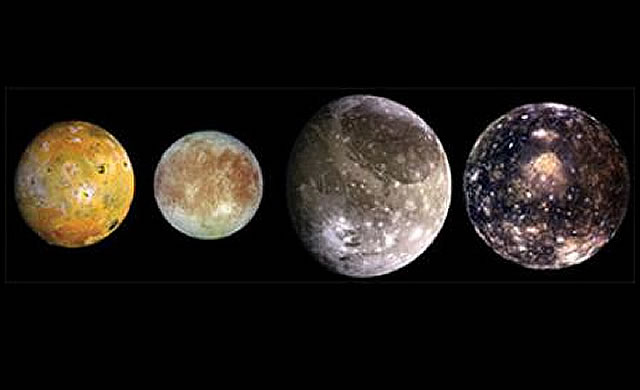
Un nuovo studio suggerisce la possibilità di trasferimento della vita dal sistema solare interno verso le lune che orbitano intorno a Giove e Saturno. Anche se molto rara, questa ipotesi non può essere esclusa. La vita sulla Terra o Marte potrebbe essere stata trasportata sulle lune di Giove o Saturno attraverso le rocce partite da questi pianeti, dicono i ricercatori. Questi risultati suggeriscono, qualora gli scienziati rilevassero segni di vita su quelle lune, che potrebbe essere contemplata la possibilità che è la vita sia arrivata da altrove, piuttosto che abbia avuto origine localmente. L’idea che la vita può diffondersi attraverso lo spazio è nota come panspermia. Una delle varianti della più generica panspermia, è chiamata lithopanspermia e riguarda l’idea che la vita possa viaggiare su rocce espulse dalla superficie di un cosiddetto mondo.
Se questi meteoroidi racchiudono fortemente abbastanza organismi, potrebbero seminare la vita su un altro pianeta o sulla sua luna. Anche se la lithopanspermia potrebbe sembrare inverosimile, una serie di scoperte effettuate su meteoriti ne rivelano la possibilità. Per esempio, più di 100 meteoriti provenienti da Marte sono stati scoperti sulla Terra, probabilmente partiti dal pianeta rosso e che poi si sono schiantatati qui. Alcuni ricercatori hanno suggerito che la vita sulla Terra potrebbe essere stata originariamente seminata da meteoriti provenienti da Marte. Un grande sforzo della ricerca ha esplorato il pianeta rosso in cerca di segni di vita una volta probabilmente presente e che forse potrebbero ancora esisterne tracce lì oggi, in base ai risultati che mettono in evidenza che Marte una volta sia stato significativamente più ospitale per la vita di quanto lo sia adesso, e che rifugi per la vita potrebbero essere rimasti nascosti sotto la sua superficie. Un meteorite marziano, Allan Hills 84001 ( ALH84001 ), è stato inizialmente indicato come prova e contenere tracce di vita. Tuttavia, la ricerca ha portato poi a rilevare che ogni elemento in questo meteorite, potenzialmente indicativo per la vita, potrebbe invece essere stato generato in forma inorganica. Simulazioni al computer del passato hanno anche suggerito che la materia è decollata dalla Terra da impatti cosmici che poteva essere sfuggita alla forza di gravità della Terra ed atterrata sulla Luna. Miliardi di anni di polvere della Terra si possono essere accumulati sulla superficie lunare , tanto quanto 22 tonnellate di materiale terrestre si sviluppa su ogni 38 miglia quadrate ( 100 chilometri quadrati ) della Luna . Se fosse vero, la Luna potrebbe contenere fossili di alcuni dei primi segnali vitali della Terra . La scoperta di organismi sulla Terra che possono sopravvivere in ambienti che una volta si pensavano troppo estremi per la vita, ha suscitato l’interesse sulle lune più esterne del sistema solare, come la luna Europa di Giove o della luna di Saturno, Titano, le quali a loro volta potrebbero ospitare la vita .
A new study suggests the possibility of transfer of life from the inner solar system to the moons orbiting Jupiter and Saturn, although very rare, cannot be ruled out. Life on Earth or Mars could have been brought to the moons of Jupiter or Saturn on rocks blasted off those planets, researchers say. These findings suggest if scientists ever detect life on those moons, they might have to contemplate the possibility that it came from elsewhere rather than originating there on its own. The idea that life can spread through space is known as panspermia. One class of panspermia is lithopanspermia—the notion that life might travel on rocks knocked off a world’s surface.
If these meteoroids encase hardy enough organisms, they could seed life on another planet or moon. Although lithopanspermia might seem farfetched, a number of meteorite discoveries suggest it might at least be possible. For instance, more than 100 meteorites originating from Mars have been discovered on Earth, blasted off the red planet by meteor strikes and eventually crashing here. Some researchers have even suggested that life on Earth may have originally been seeded by meteors from Mars. A great deal of research has explored whether the red planet once harbored life and whether life might still exist there today, based on findings that Mars might once have been significantly more hospitable to life than it is now, and that refuges for life could remain hidden under its surface. One Martian meteorite, Allan Hills 84001 (ALH84001), was even initially claimed to contain evidence of life. However, research since has revealed that every item on this meteorite that was potentially suggestive of life could be generated inorganically. Past computer simulations also have suggested that matter blasted off Earth by cosmic impacts could have escaped the pull of Earth’s gravity and landed on the Moon. Billions of years of Earth dust may have accumulated on the lunar surface—as much as 22 tons (20 metric tons) of Earth material is spread over every 38 square miles (100 sq. km) of the Moon. If true, the Moon could hold fossils of some of the earliest microbial life on Earth. The discovery of organisms on Earth that can survive in environments once thought too harsh for life has piqued interest over whether the moons in the outer reaches of the solar system, such as Jupiter’s moon Europa or Saturn’s moon Titan, could host life.
Source/Continue reading → Phys.org





















